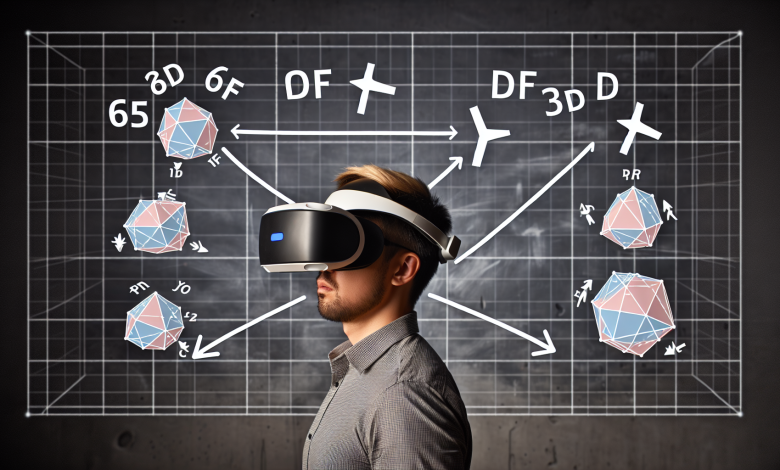Understanding 6DoF: The Key to Braindance’s Immersive Virtual Reality Experiences

In the rapidly evolving landscape of virtual reality, achieving true immersion is the ultimate goal. braindancevr is a company at the forefront of this pursuit, pushing the boundaries of what’s possible in VR. Their focus on creating deeply immersive experiences is made possible by a groundbreaking technology known as 6DoF, or Six Degrees of Freedom, which this article will explore in the context of Braindance’s innovative technology and the future of immersive virtual reality.
What is 6DoF?
Definition of 6DoF
Six Degrees of Freedom (6DoF) refers to the ability of a rigid body to move in three-dimensional space, which in virtual reality, translates to complete freedom of movement for the user. This is achieved by tracking two types of motion: translational and rotational. Translational motion covers movement along three axes: forward/backward, left/right, and up/down. Rotational motion covers tilting the head up and down (pitch), turning it left and right (yaw), and tilting it from side to side (roll). The combination of these six movements allows users to navigate a virtual environment as they would in the real world, creating a seamless and believable experience.
Comparison to 3DoF
The distinction between 6DoF and its predecessor, 3DoF (Three Degrees of Freedom), is crucial. 3DoF systems only track rotational motion, meaning users can look around but cannot physically move within the virtual environment. This limitation hinders immersion and can cause motion sickness. The table below highlights the key differences:
| Feature | 3DoF (Three Degrees of Freedom) | 6DoF (Six Degrees of Freedom) |
| Motion Tracked | Rotational only (pitch, yaw, roll) | Rotational and Translational |
| User Movement | Look around from a fixed point | Move freely within the virtual space |
| Immersion Level | Limited | High |
| Examples | Google Cardboard, Oculus Go | Oculus Quest, HTC Vive, Braindance VR |
The ability to physically move within a virtual space is what sets 6DoF apart and makes it a cornerstone of modern immersive experiences. It transforms the user from a passive observer into an active participant.
The Technology Behind Braindance
Gaussian Splatting Technology
Braindance’s commitment to realism is powered by a cutting-edge technology called Gaussian Splatting. This 3D reconstruction technique creates photorealistic scenes from a series of images, capturing the world in incredible detail. Braindance uses a sophisticated rig of 165 cameras to capture every angle of a performance, and this data is then processed into a “splat,” a volumetric representation of the scene that can be rendered in real-time.
How Gaussian Splatting Enhances VR Experiences
Gaussian Splatting profoundly impacts the quality of VR experiences. By reconstructing images of human bodies with unparalleled realism, Braindance creates virtual characters that are nearly indistinguishable from their real-life counterparts. A custom-built AI algorithm further refines the visual data, ensuring smooth and lifelike animations. The result is an immersive experience where users feel a genuine sense of presence and connection with the virtual characters. The ability to move around these photorealistic figures with 6DoF and observe them from any angle creates a level of intimacy and realism previously unattainable in VR.
The Importance of Immersive Experiences
Enhancing User Engagement
The synergy of 6DoF and Gaussian Splatting dramatically enhances user engagement. Free movement in a photorealistic virtual world heightens the sense of presence, leading to a more engaging and memorable experience. The ability to physically interact with the environment feels natural and intuitive, breaking down the barriers between the real and virtual worlds.
Applications Beyond Entertainment
While Braindance focuses on entertainment, the technologies they are pioneering have far-reaching implications. In education, 6DoF and Gaussian Splatting could create realistic historical reconstructions or scientific simulations. In training, professionals could practice complex procedures in a safe, controlled virtual environment. The potential applications are vast, and we can expect to see them integrated into a wide range of industries as the technology matures.
The Future of 6DoF and Virtual Reality
Trends in VR Technology
The VR industry is constantly innovating, with trends pointing towards more immersive and seamless experiences. Inside-out tracking is now standard for 6DoF headsets, and higher resolution displays, wider fields of view, and more powerful processors are contributing to more realistic and comfortable VR. The integration of AI is also opening up new possibilities for dynamic and responsive virtual worlds.
Braindance’s Vision for the Future
Braindance is actively shaping these trends, with a vision to blur the line between reality and virtuality. They plan to continue refining their Gaussian Splatting technology, pushing the boundaries of photorealism. By combining this with advanced 6DoF tracking and AI-driven interactivity, Braindance aims to create transformative virtual experiences. As their CMO, Paulina, stated, “Our technical team has done an exceptional job combining advanced tech with compelling content — it’s like a platform created by nerds for nerds.
6DoF is the key to unlocking the full potential of virtual reality. It creates a sense of presence and immersion that is not possible with 3DoF technology. When combined with the realism of Gaussian Splatting, as demonstrated by Braindance, the result is a revolutionary VR experience. As this technology evolves, we can expect more engaging, realistic, and impactful virtual worlds. To learn more about the future of immersive VR, explore the innovative work being done at braindancevr.





